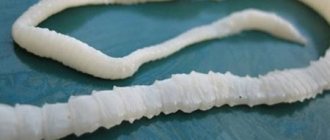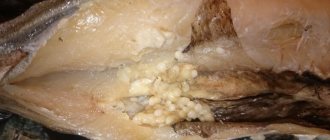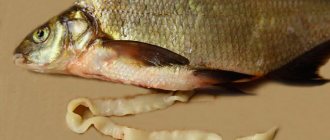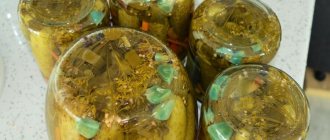What is a tapeworm
You can learn what a tapeworm looks like from the photos that are freely available on the Internet. The parasite is a helminth from the group Pseudophyllidea. This worm can grow up to 25 cm in length and 2 cm in width. The tape shape of the tapeworm makes it easy to distinguish it from other helminths.
It looks like an uneven, intertwined white ribbon. Its structure is quite simple:
- head size 5 mm;
- a large number of segments in adults up to 4 thousand.
The helminth needs segments for reproduction. They produce eggs, which are subsequently released into the environment. The parasite is able to recover from just one segment into a full-fledged tapeworm.
Which fish are susceptible to tapeworm infestation?
The tapeworm is capable of infecting 47 species of fish. Invasion often occurs in river fish, these are:
- crucian carp;
- silver bream;
- pike;
- bream;
- roach.
Typically, saltpeter fish is found in polluted water bodies. The first sign of the presence of helminths in water is an unpleasant odor. It appears due to the fact that the worm is tearing the fish apart. Its mass death causes water poisoning.
Infection of fish also occurs in ecologically clean regions. The parasite is often found in salmon, roach, herring, and pollock. It should be noted that whitefish, peled, and pike perch are not susceptible to tapeworm infection.
Don't look for something safe - parasites are everywhere
The greatest danger to fish is parasites. Despite the widespread belief that fish from cold seas are safe, there are helminths in them, they are just much less common. You cannot eat sockeye salmon, coho salmon, omul, or muksun fish raw. The safest in this regard are tuna, halibut and salmon.
@ falco pixabay.com
Predators and scavengers have the most unfavorable chances of becoming infected with parasites in captivity. Such fish must not be consumed fresh, regardless of its habitat.
What does tapeworm look like in fish?
It is not difficult to recognize infected fish; they appear on the surface and are inactive. Therefore, it is better to avoid catching weakened waterfowl, since eating contaminated meat is a dangerous decision for humans. His health is at risk.
When cutting up an infected fish, you can see how a white flat tapeworm has completely filled its intestines. Photos presented on the Internet will help you learn more about the appearance of the tapeworm.
Diagnostics and treatment measures
Very often such diseases are confused with various disorders of the gastrointestinal tract, hepatitis, and pneumonia. Due to the variety of symptoms, doctors can make an incorrect diagnosis, thereby prescribing the wrong treatment, which not only will not help overcome the disease, but will also aggravate the patient’s condition.
Among the folk remedies, laxative herbs help in the fight against worms: decoctions of elecampane and celandine. Another good way is to eat carrots, pomegranates, garlic, and walnuts. Pumpkin seeds are an excellent anthelmintic. It cannot be said that these recipes will defeat the disease, but they can be used as preventive measures.
Fish is not only tasty meat, but also a source of beneficial minerals and nutrients that humans need. But it is important to understand how dangerous it is to eat raw fish. Whatever method you choose when processing meat - heat, smoking or salting - remember the rules of hygiene. Take care of your health and the health of your loved ones.
Helminth development
Tapeworms in fish can reach a length of up to 25 cm and cause serious illness. The body consists of segments, which, after maturation, separate and are capable of independent existence. A special feature is that the worm is capable of producing male and female reproductive cells at the same time. They are attached to the walls of the internal organs using suction cups, which are located on the front of the body.
The broad tapeworm can lay up to several thousand eggs per day. The lifespan of each individual can reach 20 years.
The fish tapeworm goes through several stages in its development.
- Fish become infected with larvae by eating cyclops, crustaceans, snails and other small inhabitants of water bodies.
- Fish infected with larvae are caught and eaten by waterfowl.
- Further development of the larvae occurs in the body of the birds, and they, along with feces, again enter the water.
- Particles of feces are again swallowed by small inhabitants of the reservoir, on which freshwater fish feed, and are again infected with tapeworm. But at this stage, larvae form, which can become dangerous to humans.
Most often, fish with white meat, such as bream, roach, pike, and sop, are susceptible to tapeworm. As the tapeworm grows, all the internal organs of the fish are compressed. The swim bladder contracts, swimming function is impaired, so the fish floats to the surface and can remain belly up for a long time.
Diplostomiasis
Diplostomiasis is quite common in fish living in fresh or slightly salted water. The disease is caused by a trematode larva. Birds are considered the final host. Penetrating inside the body, the worms lay their eggs in the fish. Together with bird feces, they end up in water bodies, where they find a temporary host for maturation - mollusks. Having reached the required stage of development, the tapeworm leaves the body of the mollusk and infects the fish. The worm enters the body of a marine inhabitant through the skin or through the eyes. It can live inside for up to several years, developing into metacercariae. This causes damage to the eye and blindness. When infected waterfowl enters a bird's food supply, the infection process begins in cycles. For humans, this type of helminth is considered not dangerous.
How does infection occur?
Only after passing certain stages of development can a helminth become a sexually mature individual. To do this, he must alternately get to two intermediate and one main owner.
The life cycle of a tapeworm consists of several stages.
- Through the feces of tapeworm-infected mammals, the worm releases several million immature eggs into the environment every day. The eggs remain viable for 30 days. During this time, they either fall into the water, where their further development occurs, or die.
- In a pond, free-swimming larvae (procercoids) are released from the eggs. They become prey for copepods, making them the first intermediate hosts of the worm.
- Fish, having swallowed infected crustaceans, become a new intermediate host of the helminth. Parasitizing in the abdominal cavity, procercoids gradually pass into the next larval stage of plerocercoids.
- The larvae complete development in the body of the main host. Its role is played by people or animals (bears, foxes, dogs and cats) consuming diseased fish. Once in the digestive tract, plerocercoids attach to the intestinal walls, where in a short time they grow into a sexually mature worm.
A fish tapeworm in the human intestine can retain the ability to reproduce for 20 years.
Note! A helminthic infestation can only be acquired by eating tapeworm fish. Larvae floating in water bodies do not pose a danger.
What to do after eating sick fish?
You should consult a doctor as soon as possible.
After eating diseased fish, you should see a doctor as soon as possible for timely diagnosis and early therapeutic measures. A mandatory point is to conduct an examination of all family members, due to the ability of many fish worms to become infected through contact. In order to avoid re-infection, careful adherence to personal hygiene rules and special dietary nutrition are a prerequisite during therapy.
How can you tell if a fish is infected with helminths?
In order to protect yourself and your family from infection with parasites from fish, you should know what an infected product looks like:
- the muscles are soft and there is no rigor; if you press on such a fish, the hole will not disappear;
- cloudy and dry mucous membrane in the pupils;
- easy separation of scales, under which sticky skin is visible;
- the fish belly looks saggy and swollen;
- marshy gills;
- the fish emits a pungent odor;
- a strongly protruding anus, from which cloudy discharge may flow.
Why is tapeworm dangerous?
This parasite is dangerous in the later stages of the disease. There are several reasons for this:
- this worm is a hermaphrodite, so if at least 1 worm enters the body, this is enough for reproduction;
- The tapeworm lays about 1 million eggs per day, the lifespan of each individual can reach 20 years;
- the disease is difficult to detect, so the patient seeks help in a critical situation.
Important to remember! You should undergo medical examination periodically! This will help identify the disease in the early stages and easily get rid of the disease. The tapeworm in fish is dangerous to humans, not the product itself.
Solitaire fish: signs, behavioral characteristics
The tapeworm in the abdominal cavity of an aquatic inhabitant quickly increases in size. It compresses the swim bladder and other organs, which leads to their atrophy. Tapeworm in fish causes metabolic disorders and endogenous intoxication. The altered swim bladder loses its hydrostatic function.
There are a number of signs that allow you to visually identify an infected individual:
- saltpeter fish rarely descends to a depth of more than 3 meters. Usually floats on the surface of the water (often on its side). From time to time he rolls over onto his back;
- the belly is hard and swollen. When pressed, a tapeworm segment may appear from it;
- When playing, it behaves passively and practically does not resist. Once caught, it quickly dies.
You can verify the presence of the parasite during the process of gutting the catch: flat white worms will be found in the abdominal cavity of the tapeworm fish. Helminth larvae are localized in the liver, intestines, and muscle layer near the fins. It is impossible to see them with the naked eye.
The peak of tapeworm infestation occurs in the summer months, but at other times of the year the likelihood of catching sick fish is quite high.
Is it possible to eat tapeworm fish?
Is helminth dangerous for humans? The prevailing opinion among fishermen that fish infected with tapeworm is not dangerous if the parasite is removed from it is only partly true. The worm in fish itself does not really pose a health threat. The problem is that tapeworm larvae, invisible to the naked eye, remain in the muscle tissue. Once they enter the human body, they begin to actively parasitize. Within 12 months, the plerocercoids reach the final stage of development, turning into an adult worm. Worm infestation can be asymptomatic. In some cases, dizziness, nausea, abdominal pain, disruption of the digestive system, and irritability are noted.
Tapeworm in fish is dangerous for humans due to diphyllobothriasis. The parasitic disease causes damage to the gastrointestinal tract and contributes to the development of megaloblastic anemia. There are known deaths due to intestinal obstruction.
Is it possible to eat saltpeter fish? Ideally, a caught sick individual should be thrown away, wrapped in a tight bag. You can bury it far from a body of water (the tapeworm larvae die in the ground). It cannot be released back into the water due to the danger of invasion of other inhabitants.
Smoked and dried fish
Infection through dried fish is possible. An adult tapeworm usually dies when dried, but the eggs can remain viable for a long time. Smoked fish can also be dangerous if the cooking technology is not followed. If the fish has not been subjected to sufficient heat treatment, the risk of infection is very high. Tapeworm can also be found in everyone's favorite herring.
You should only buy fish from trusted sellers. It needs to be thoroughly examined. If you suspect that the fish is infected, you should refuse to purchase.
Can there be worms in pink salmon, chum salmon, salmon and other red fish?
Currently, delicious dishes made from red fish, such as salmon, trout, pink salmon, and chum salmon, are very popular. Preference is given to culinary products made from raw or half-raw fish with minimal use of salt and heat treatment (sushi, fresh fish salads). Gourmets claim that this way the natural taste and nutrients of the product are preserved. As a gift for such delicacies made from red fish, for example, pink salmon, you can also purchase their natural inhabitants - worms. You may not even suspect that the infection with worms came from pink salmon, salmon, and chum salmon, because the manifestations of the diseases are nonspecific. They can manifest as skin rashes, digestive disorders and other symptoms.
What worms are in red fish?
The causative agents of helminthiasis are the larvae of flat and round worms, which are present in almost all types of industrial fish, including chum salmon, pink salmon, salmon, and trout.
Diphyllobothriasis is a helminthic infestation caused by the broad tapeworm. In red fish, such as salmon, trout, chum salmon, pink salmon, helminth larvae are located in capsules - thin translucent shells that look like grains of rice (pictured above). They are located in the gastrointestinal tract, in caviar, milk, liver and muscles. When the capsule is destroyed, the parasites enter the fish's body. They appear white or milky in color, up to 55 mm long and up to 3 mm wide.
When they penetrate the human body, the larvae grow into a parasite up to 12 meters or more in length. It can live in the body for up to 15 years, causing poisoning with varying intensity. The main signs of the disease are weakness, frequent headaches, loss of appetite, nausea and vomiting, heartburn, belching, stool disorders. An itchy skin rash may also appear. The most common infection with the larvae of these worms is observed in pink salmon and chum salmon.
Nanophyetosis is a helminthiasis that can affect pink salmon, chum salmon, trout, and salmon. The larvae of this group of parasites are resistant to treatment - in the refrigerator at a temperature of 4°C they remain viable for 15-16 days, in boiling water they die after 2 minutes, and when salted they die in 3-5 days. Upon penetration into the human body, they cause severe diarrhea, and in chronic cases, anemia.
Anisakiasis is a helminthiasis caused by roundworms. Almost all types of marine fish are infected with the larvae of these parasites. Red fish are no exception - pink salmon, trout, chum salmon. The most infected with these worms is chum salmon, followed by pink salmon and salmon. In the body of a fish, helminths are located in the liver, spleen, abdomen, gastrointestinal tract, milk and eggs, but most often in the muscles. The worms look like spirals of whitish, cream or brown color, about 2-5 cm long, up to 2 cm wide.
When entering the human body, anisakids can cause intestinal ulcers, as these worms penetrate the mucous wall of the stomach and intestines.
Is it possible to eat red fish with worms?
According to sanitary standards, red fish infected with the above worms is considered “conditionally suitable” for consumption, but it requires a special treatment regime that guarantees complete neutralization of the parasites.
To prevent infection with worms, you should not eat raw red fish. You need to fry it covered or in the oven at a temperature of 180-200°C, cook for 10-15 minutes in boiling water. Industrial preparation methods completely neutralize worm larvae. When frozen, the helminths of red fish (pink salmon) die at a temperature of –20°C within 2 days, in a freezer at –4°C – after 25-30 days, and when salted at home – no earlier than after 15 days.
zhkt.guru>
What to do if you feel bad about throwing away your catch?
If it is a pity to part with the catch, the tapeworm can be neutralized by high-quality processing of the fish. To protect yourself from the penetration of parasites, you must adhere to certain rules. First of all, you need to thoroughly gut the carcass. Pay special attention to the tapeworm itself: all segments must be removed.
After this, choose one of the methods of processing the fish, in which the larvae are guaranteed to die:
- freeze at -20C (the carcass is kept in the freezer for at least 24 hours, ideally 3 days);
- pickle. Take salt at the rate of 1220% of the total weight of the fish. The time for complete salting out is 612 days, depending on the density of muscle tissue;
- cut into small pieces, cook for at least 30 minutes from the moment of boiling or fry for 1520 minutes on each side;
- bake over an open fire;
- smoke hot.
Viable larvae, invisible to the eye, can end up on hands and kitchen utensils. Hands, knives, cutting boards must be thoroughly washed with laundry soap.
Saltpeter fish is significantly inferior in taste and nutritional value to healthy individuals.
Note! The most dangerous in terms of tapeworm infection are dishes made from raw and lightly salted fish (sushi, stroganina and others), including caviar. This also includes cold smoked and dried fish. With weak salting and no heat treatment, plerocercoid larvae do not die and retain the ability to parasitize in the intestines of humans or animals, passing into the adult stage.
The fish tapeworm infects mainly representatives of the carp family, which are traditionally caught. Crucian carp and bream are especially vulnerable. In salt water the parasite occurs on a smaller scale. The most commonly caught sea creature is tapeworm pollock.
On a note! A representative of the cod family usually arrives in stores in a deep-frozen state; after heat treatment, it can be eaten. A person can become infected with a helminth only in one case: by eating fish whose muscle tissue contains plerocercoids. Prolonged heat treatment of fish and compliance with sanitary and hygienic standards will reduce the risk to a minimum.
And in conclusion, one more piece of advice: do not buy dried bream or cold smoked pike from random sellers. Along with a gastronomic delicacy, there is a high risk of introducing a fair amount of viable tapeworm larvae and other worms into the stomach.
Most people are aware of the possible presence of worms in their body or in the body of animals. A parasitic worm, also known as a helminth, lives in every third person. But few people know that the fish they eat can also contain this parasite.
Safety measures against infection with fish diseases
To protect yourself from infection with fish diseases caused by parasites, you must follow the recommendations for preparing fish and personal hygiene when cutting:
- You cannot eat raw or half-raw fish, caviar, or planed fish.
- Carefully inspect the fish carcass when cutting, remove all visible parasites, thoroughly clean and rinse with running water. All tools used for cutting fish are also washed.
- Boil or fry the fish for at least 20 minutes at a temperature not lower than 100°C.
- Do not dry fish or salt it. Salt does not kill many pathogens.
Following simple rules will protect you from serious diseases. Fish will remain a healthy product and will not cause any harm.
Symptoms of human infection
In the first stages of tapeworm infection, a person may not feel any changes in his body. Tapeworm, unlike other helminths, has less effect on well-being, and therefore its presence in the body can go unnoticed for a long time. Mild symptoms of illness may be mistaken for another disease. Since the worm settles in the intestines, a person may experience problems with the gastrointestinal tract.
The main symptoms of tapeworm infection:
- loose stools or constipation that occurred suddenly and for no reason;
- increased salivation;
- dizziness;
- sudden weight loss;
- intestinal obstruction;
- irritability;
- a feeling that something is moving inside (it is not the parasite itself that is moving, but the muscles contracting under its influence);
- anemia;
- weakness and apathy;
- decreased appetite or, conversely, constant hunger;
- small red wounds appear on the tongue;
- gagging and nausea.
In some countries, tapeworm is specially introduced into the human body so that it helps quickly and effectively lose weight. Afterwards the parasite is removed. You should not do this intentionally, because helminth infection can lead to very serious health consequences.
Frequently asked questions and answers
Are there worms in sea fish?
In which bodies of water is there a high risk of fish becoming infected with worms?
Clonorchiasis is caused by flukes that are 10-20 mm long. Mature worms settle in the human body in the gallbladder and ducts or pancreas. are carps and crayfish such as calanus. A person becomes infected with clonorchiasis by eating uncooked fish or crayfish. Helminths can live in the body for up to 40 years. The disease is manifested by fever, allergic rashes and an increase in liver size.
Treatment methods
{banner_banstat9}
As a rule, getting rid of the parasite is not very difficult. You can be treated with traditional methods, or play it safe and immediately contact a qualified specialist. Drug treatment can only be prescribed by a doctor, based on the patient’s condition and his tolerance to the active components of the drug. In rare and advanced cases, it is necessary to resort to surgical intervention.
In drug treatment, drugs that include mebendazole, albendazole or carbendacim are most often prescribed. Excellent representatives of this group are: vermox, biltricide, sanoxal, medamine and many others. Depending on the choice of drug, treatment can take place with a single tablet or a course of up to 3-4 days. In rare cases, worms do not respond to drugs, and scientists still do not know the reason for this. The solution would be to repeat the course after 3 weeks; as a rule, this helps.
Surgery is required in extremely rare cases. The reason for this is an advanced form of infection, brain damage, or inflammation of the appendix due to the development of tapeworm.
Also, surgical intervention may be prescribed if drug treatment is contraindicated, when the parasite has settled in vital organs.
Traditional methods most often include treatment with raw garlic, raw unpeeled pumpkin seeds or castor oil. This method is used more to relieve symptoms rather than to completely cure the parasite.
Worms in aquarium fish
Aquarium fish also suffer from worms.
Methods of infection:
- Through live food.
- From untreated water.
- From new, acquired fish.
Prevention:
- Live food must be kept in water for several days for the parasites to come out naturally.
- Clean the water thoroughly before adding it to the fish.
- Keep new fish in quarantine for 2-3 weeks.
Aquarium fish worms are not dangerous to humans. The temperature of our body is detrimental to parasites of aquarium fish. And they are not eaten. To prevent infection, it is enough to wash your hands with soap after various manipulations with the aquarium.
Don't be careless! Follow all the recommendations listed in the article.











